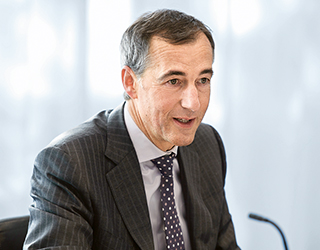Group investments

“In a year of considerable market volatility, we have continued to deliver strong value to the Group.”
Guido Fürer
Group Chief Investment Officer
Strategy
Swiss Re’s investment portfolio provided a solid contribution in 2018, despite a negative impact from the recent change in US GAAP accounting guidance. Fundamentally, the portfolio performed well with no material impairments and a running yield that trended upward during the year. Overall, there were no significant changes to Swiss Re’s asset allocation during 2018 and the Group remains flexible should there be a change in the investment outlook or if any market opportunities arise.
Financial markets overview
Financial markets in 2018 were mainly driven by a series of political risks, monetary policy developments and late-cycle concerns in the US. In terms of politics, the US–China trade dispute, Brexit-related uncertainties and the Italian budget standoff weighed on investor sentiment, particularly in the fourth quarter.
In contrast to 2017, most asset classes saw heightened volatility in 2018. Early in the year, equity markets came under sharp pressure before rebounding again in spring. Tailwinds from the US tax stimulus led to outperformance from US equities relative to other major stock markets globally. Equity markets then sold off in Q4 amid concerns over a global growth slowdown as well as seasonally thin liquidity conditions in December, resulting in the S&P 500 index ending the year down 6%. While credit spreads were less affected by the aforementioned market turbulences for most of the year, investment-grade corporate bond spreads widened considerably across all regions over the final two months. Government bond yields increased for the majority of the year, most notably in the US, before partially reversing in November and December.
Overall, global growth started to slow, though continues to remain above-trend. Inflation picked up slowly in many regions and central banks continued to normalise their monetary policies gradually, most notably in the US.
Net investment income
in USD billions, 2018
4.1
(2017: USD 3.7 billion)
Group return on investments
2018
2.8%
(2017: 3.9%)
Fixed income running yield
2018
2.9%
(2017: 2.9%)
Investment result
The Group’s investment portfolio, excluding unit-linked and with-profit investments, decreased to USD 122.6 billion at the end of 2018, compared to USD 131.7 billion at the end of 2017. The decrease was driven by the strengthening of the US dollar as well as the impact from credit spread widening and a rise in interest rates.
The return on investments for 2018 was 2.8%, reflecting a negative impact from the recent change in US GAAP accounting guidance. The result was primarily driven by net investment income, which contributed more significantly than in prior years, reflecting a higher quality of earnings. This compared to a return of investments of 3.9% in 2017, with the decrease almost entirely attributable to a reduced contribution from equity securities. The Group’s non-participating net investment income increased to USD 4.1 billion in 2018 compared to USD 3.7 billion the prior year. The Group’s fixed income running yield was steady at 2.9%.
The Group reported non-participating net realised investment gains of USD 0.1 billion in 2018 compared to USD 1.7 billion in 2017, as the prior year benefited from significant realised gains from sales within the equity portfolio versus market value losses in 2018.
Outlook
Global economic growth is expected to slow in 2019, particularly in advanced markets. Across the US and Europe, tighter financial conditions and lingering political concerns as well as the impact from a waning US fiscal stimulus are likely to weigh on growth. Asia is expected to see economic growth slow moderately, but remains the strongest region globally, while Latin America is expected to see a modest growth recovery, albeit from a low base.
Moderate global monetary policy tightening is set to continue, including by the Federal Reserve, whose hiking cycle and balance sheet reduction are approaching the final stages. Meanwhile, the European Central Bank is likely to keep its refinancing rate unchanged in 2019, having fully unwound its asset purchase programmes in 2018.
In contrast to last year’s outlook, which was more balanced, the balance of risks is skewed to the downside, amid increasing protectionism (e.g. US–China trade conflict) and ongoing monetary policy tightening. Late-cycle concerns (especially in the US) and the political climate (including Brexit and the European Parliament election as well as elections in India, South Africa and Argentina) add to the uncertainty. We thus continue to maintain a well-diversified and high-quality investment portfolio, braced for further bouts of market volatility in the coming year.